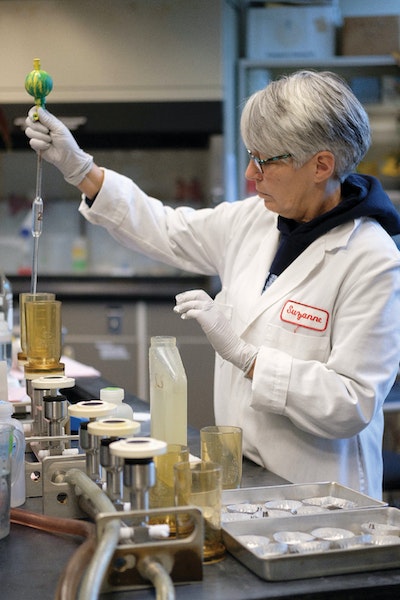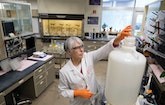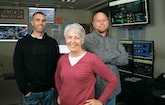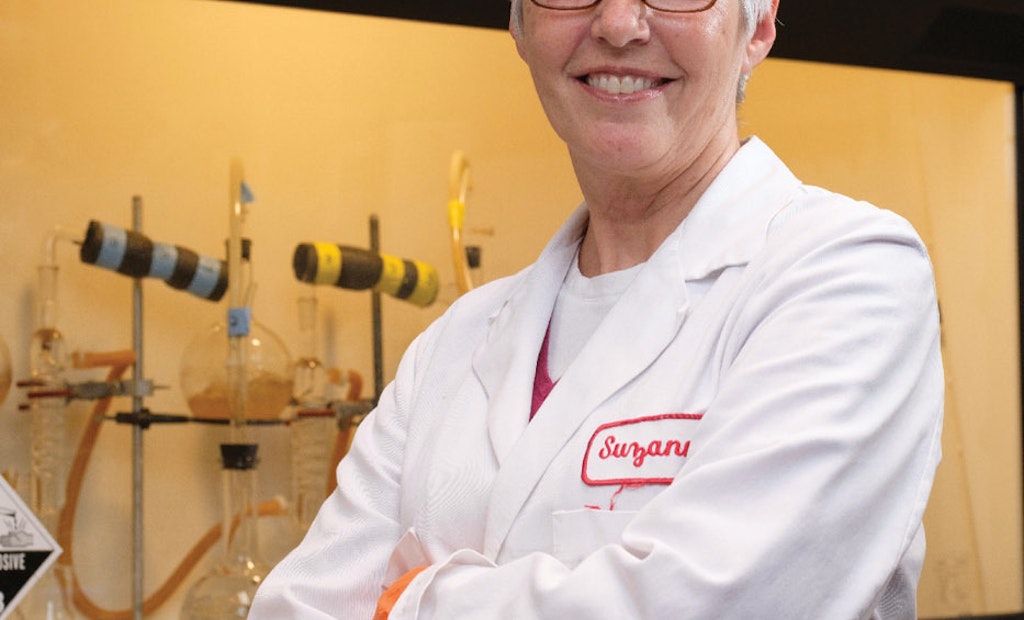Interested in Dewatering/Biosolids?
Get Dewatering/Biosolids articles, news and videos right in your inbox! Sign up now.
Dewatering/Biosolids + Get AlertsStudying to be a dentist didn’t light a fire of enthusiasm for Suzanne Potts, but it did ignite her love of chemistry and the laboratory. She switched to environmental science.
An associate degree in environmental science from University of Washington enabled Potts to work for an environmental analytical lab. When it closed in 1994, Potts found what she thought was a temporary job at the King County Wastewater Treatment Division South Plant in Renton, Washington. “What began as an accident — I never expected to be hired — turned out to be a great career,” she says. “I found the lab work interesting, intricate, and complex.”
Potts helped guide the laboratory from time-consuming manual process analysis and calculations recorded on bench sheets to remote instrumentation and laboratory information management system software. Over her 24 years, she gained a reputation for going beyond the call of duty. From mentoring new staff to being the go-to person for key projects, Potts, a process laboratory specialist III with a Group III Wastewater Operator license, is recognized as a role model throughout her division.
In 2016, Potts received the Laboratory Analyst Excellence Award from the Water Environment Federation and the Pacific Northwest Clean Water Association. In 2017, South Plant earned its 19th Platinum Peak Performance Award from the National Association of Clean Water Agencies.
Keeping Seattle safe
In service since 1965, the 325 mgd (design) activated sludge South Plant is one of three facilities serving the Seattle metro area. It averages a dry-weather flow of 96 mgd and treated 26 million gallons of septage in 2016.
Influent passes through eight mechanically cleaned bar screens (Huber Technology), 12 primary sedimentation tanks, and four 4.28-million-gallon activated sludge tanks with four multistage blowers (Turblex Inc. a Siemens Company) and three single-stage blowers (Hoffman & Lamson, Gardner Denver Products). Activated sludge flows to 24 100-foot-diameter secondary clarifiers.
A 12.5 percent solution of sodium hypochlorite disinfects effluent in two channels. Each channel has three 1 hp pumps with a Water Champ 20 hp rapid-speed mixer (Evoqua Water Technologies). A 9-foot-diameter pipe transfers effluent 10 miles to Elliot Bay.
Mixed sludge is pumped to six dissolved air flotation sludge thickeners (WesTech Engineering), then to four anaerobic digesters before blending in a fifth tank. Liquid biosolids are thickened in three D-Series centrifuges (Andritz Separation), each able to yield a woods application product at 18 percent solids or a longer-haul product at up to 25 percent solids. The plant’s Binax scrubbing system produces gas to an 8 MW cogeneration facility that provides hot water in a loop for the digesters, buildings, and underground galleries. The laboratory has five full-time technicians and a full-time temporary technician.
Making inroads
Not everyone in the lab welcomed the technical advances Potts proposed, fearing they would work themselves out of a job. But the operators gave Potts and Curtis Steinke, process analyst, their full support as they campaigned to eliminate multiple samplers throughout the plant.
“The operators collected composite samples daily, then brought all those bottles to the lab,” Potts says. “Furthermore, the samplers were old and required lots of monitoring and maintenance.”
After the county purchased probes integrated with SCADA software, Potts verified their data against samples she drew and analyzed in the lab. The probes improved process efficiency and reduced operation and maintenance costs.
In 2012, the 36 mgd (design) Brightwater membrane bioreactor came online, doubling South Plant’s lab work. Simultaneously, the laboratory was razed to build a two-story structure, forcing technicians to establish lab space in other areas of the plant and in a temporary trailer. “Hiring help wasn’t in the budget, so we invested in equipment to improve efficiency,” Potts says.
Leading the way was the AQ2 auto-analyzer (SEAL Analytical) to expedite test results for phosphorus, nitrate, and nitrite. Compared with manual methods, it uses 2 ml samples instead of 100 ml and about 80 percent less reagent and glassware. It also runs automatically, freeing technicians for other work.
Time and space savings
Three 8-tube Tecator digestion systems and scrubbers (Foss) for TKN analysis replaced a leaky, dirty, wall-sized digestion unit with fume hood that used 300 ml samples and a mercury catalyst. The new units have a smaller footprint, use 25 ml samples, and work with nonmercury digestion reagent (North Central Laboratories).
“We used to run daily TSS samples on mixed liquor, one each, four trains, along with return activated sludge and unchlorinated effluent, one each from six pods,” Potts says. “Installing TSS and total solids probes reduced the number of samples we ran to verify readings weekly or every other week. This saved lab time and benefited general operations because we didn’t have to clean and maintain the composite samplers.”
A TitroLine automatic titrator with TitroSoft software (SI Analytics) is the newest addition. The lab sometimes runs as many as 20 daily alkalinity samples ranging from less than 10 mg/L to more than 8000 mg/L. “It was very time consuming,” Potts says. “Now, we set the samples on a carousel and let the titrations run while we do something else. It probably saves an hour of bench time per day.”
The new lab’s layout also enhanced efficiency, and the improved sample receiving area accommodates the numerous samples from South, Brightwater, and the smaller Carnation (480,000 gpd) and Vashon (1.4 mgd) treatment plants.
Moving ahead
Potts’ desire to become a level III process lab specialist required a bachelor’s degree. While in her early forties, she returned to the University of Washington. “My then supervisor, Barbara Strutinski, and current supervisor, Teresa Allen, were encouraging and gave me lots of latitude to complete my studies,” Potts says. “Nevertheless, working full-time, attending classes, and raising a teenage son were demanding, hard-won challenges. And I’m proud of my degree.” She graduated in 2005 with a bachelor’s degree in environmental science.
After almost a quarter century in the lab, Potts still enjoys the routine. Three new lab specialists, hired to replace retirements or transfers, have added mentoring to her agenda. She says the core part of the job takes about a year to master, but gaining the process control experience to evaluate data and take the proper actions require years.
“As I contemplate retirement, I’m thinking more about how to pass on my knowledge,” Potts says. “I’ve considered writing a lab manual, but where do I find the time? And I’ve been here so long that sometimes I don’t realize the little pieces of information in my head are not written down.”
Results and implications
Detection work remains Potts’s favorite aspect of the job. When certain samples fall outside the normal range, the game is afoot. Culprits could be a process change, a sampler issue, or something unexpected coming into the plant. For example, the plant’s bioselector process requires monitoring the phosphorus uptake across the aeration tanks. “When we see higher phosphorus levels in the effluent, we need to understand what that means from a process perspective,” Potts says. “Providing information that enables operators to make the necessary adjustments is exciting.”
Her latest project is working with the King County IT team to integrate lab instruments with a new lab information management system (Thermo Fisher Scientific). Work to implement the new system began in early 2016. Potts is helping with rigorous testing to ensure the calculations built by the vendor work and have the required specific embellishments. One customization involved more than 100 weekly TSS samples. Upon verification, calculations are integrated with the instruments and brought online.
Career challenge
The Laboratory Analyst Excellence Award was a highlight of her career, but Potts views it as an honor for her team. “No one approaches you on the street to thank you for working in the sewer department,” she says. “The job is not a great topic at dinner parties. So when you’re recognized, it has to be a thank you to the entire group.”
She believes strong outreach would remedy the lack of public recognition: “We must do a better job of stressing the well-paying, rewarding careers and great benefits available at treatment plants. As a huge portion of the workforce reaches retirement age, it’s more important than ever.”
Taking the challenge
Stepping outside her comfort zone led to a career highlight for Suzanne Potts. In 2011, the King County Wastewater Treatment Division formed the four-member Poofighters team to compete in the WEFTEC International Operations Challenge. Timed events include maintenance, process control, laboratory, safety, and collections.
Potts agreed to join the team after coach Chad Clay mentioned that the competition included a lab event. “I knew I’d be good at it,” Potts says. “After saying yes, I learned I’d also be working on pumps and confined space rescues.
“It’s hard work, but also great fun with multiple rewards. It helps develop leadership skills and teamwork, provides networking opportunities, and stimulates professional growth. It also gives us a better appreciation for what our co-workers do. My lab coworkers willingly shouldered part of my responsibilities while I trained and was gone for competitions. Without their support, I wouldn’t have been able to participate.”
The Operations Challenge presented Potts with some steep learning curves. For the 2014 collections event, she helped connect a 4-inch lateral to an 8-inch pipe and then identified six pipe defects on an inspection photo using NASSCO pipeline assessment certification program codes. Lacking experience in pipe assessment, Potts spent hours memorizing what fractures, cracks, and corrosion looked like and their codes. Manuals and notes are not allowed during the test, and any mistake adds time to the score.
After identifying the defects, Potts helped fasten Fernco couplings and a service saddle to the pipe. “The pressure is on to do everything quickly and accurately, all under the watchful eyes of hundreds of spectators cheering as loudly as crowds at Seahawks games,” Potts says.
Events are choreographed like a dance; each member knows exactly where to be and what to do every second. “Competing takes commitment, dedication, and hours of practice for that rare opportunity to show people why we’re proud of the work we do,” says Potts, who scored 100 percent on the collections test.
The division rotates personnel to enable multiple operators to compete. In 2016, Potts was the only original Poofighter. Last year, she gave up her spot, but she continues to help train the team and hopes to attend the Pacific Northwest Clean Water Association conference as an Operations Challenge judge.









